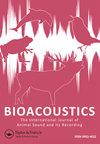骆驼口哨声:双峰驼和单峰骆驼的雄性和雌性叫声结构和语境
IF 2.1
4区 生物学
Q2 ZOOLOGY
Bioacoustics-The International Journal of Animal Sound and Its Recording
Pub Date : 2021-03-26
DOI:10.1080/09524622.2021.1889403
引用次数: 5
摘要
在反刍动物中,某些种类的鹿科动物、牛科动物和骆驼科动物能够发出高频(HF)的叫声,这可能是由空气动力学哨声机制产生的。我们分析了6只成年圈养骆驼的高频叫声:3只雄性和1只雌性双峰骆驼和1只雄性和1只雌性单峰骆驼。不同性别和个体的辐射环境不同。两个物种的雄性在发情期保护雌性时会发出声音。这两个物种的雌性在产后(雌性双歧双歧杆菌)或在抗议阻止其在围栏上移动时(雌性单峰双歧杆菌)都会向配偶发出声音。无论是物种还是性别,高频叫声都是微弱的音调,在基频上有轻微的调制。不同种属间,双歧弧菌的鸣叫声频率(1.7±0.16 kHz)显著低于单峰弧菌(3.12±0.11 kHz),鸣叫声时间(0.23±0.08 s)显著高于单峰弧菌(3.12±0.11 kHz);非线性声音现象(亚谐波和边带)在两个物种中都有出现,但并非所有个体都有。我们讨论了反刍动物高频叫声的频率与体型和声带长度的关系。我们得出结论,C. dromedarius的“口哨”高频叫声是偶蹄目动物中频率最高的叫声。本文章由计算机程序翻译,如有差异,请以英文原文为准。
Camel whistling vocalisations: male and female call structure and context in Camelus bactrianus and Camelus dromedarius
ABSTRACT Among ruminants, some species of cervids, bovids and camelids are capable of producing very high-frequency (HF) calls potentially produced by the aerodynamic whistle mechanism. We analysed the HF calls of six individual adult captive camels: three male and one female two-humped Camelus bactrianus and one male and one female one-humped C. dromedarius. Context of emission differed between sexes and individuals. Males of both species vocalised when guarding females during the rut. Females of both species vocalised towards their mates, postpartum (female C. bactrianus) or when protesting against preventing locomotion over enclosure (female C. dromedarius). In either species or sex, the HF calls were faint tonal vocalisations slightly modulated in fundamental frequency (f0). Between species, the calls were significantly lower-frequency (1.7 ± 0.16 kHz) and longer (0.23 ± 0.08 s) in C. bactrianus than in C. dromedarius (3.12 ± 0.11 kHz; 0.16 ± 0.05 s). Nonlinear vocal phenomena (subharmonics and sidebands) occurred in both species but not in all individuals. We discuss the relationship of the f0 of the HF calls with body size and vocal fold length in ruminants. We conclude that the ‘whistling’ HF calls of C. dromedarius are the highest-frequency vocalisations in Artiodactyla.
求助全文
通过发布文献求助,成功后即可免费获取论文全文。
去求助
来源期刊
CiteScore
4.50
自引率
0.00%
发文量
25
审稿时长
>12 weeks
期刊介绍:
Bioacoustics primarily publishes high-quality original research papers and reviews on sound communication in birds, mammals, amphibians, reptiles, fish, insects and other invertebrates, including the following topics :
-Communication and related behaviour-
Sound production-
Hearing-
Ontogeny and learning-
Bioacoustics in taxonomy and systematics-
Impacts of noise-
Bioacoustics in environmental monitoring-
Identification techniques and applications-
Recording and analysis-
Equipment and techniques-
Ultrasound and infrasound-
Underwater sound-
Bioacoustical sound structures, patterns, variation and repertoires

 求助内容:
求助内容: 应助结果提醒方式:
应助结果提醒方式:


